Despite working in marketing for over a decade, I’m still puzzled by the idea of product marketing.
Whether your business offers a service (say, a cleaning company) or a commodity (like a toy manufacturer), you’re marketing a “product,” right?
Heck, in my recent job hunt, I interviewed for several product marketer jobs under the caveat that I hadn’t “done product marketing,” but I’d certainly marketed a product.
But the truth is those positions wouldn’t have worked out. Product marketing is a very specific branch of marketing that requires particular skills and has its own unique benefits.
→ Download Now: Free Product Marketing Kit [Free Templates]
As job titles like “product marketer” and “product marketing manager” become increasingly popular, you may find yourself asking, “What is product marketing, exactly?” H ow does it differ from other marketing strategies? And how do you market a product in 2024?
Let’s find out.
Chapters
What is Product Marketing?
Product marketing is the process of introducing a new offering to a specific market of buyers. It involves deeply understanding a product’s target audience, using messaging to explain how it can solve that audience’s problems, and strategically positioning the product to stand out from competitors.
Product Marketing vs. Conventional Marketing
Product management and product marketing may seem like buzzwords, but they’re actually specialties dating back to the 1930s, as noted in an 800-word memo written by Procter & Gamble advertiser Neil H. McElroy.
"As obvious as it sounds, product marketing is focused on marketing the PRODUCT,” explains Anthony Pierri, co-founder & partner of FletchPMM, a product marketing firm for early-stage B2B startups. It’s a sub-field of marketing focused on product adoption and demand, whereas “marketing” is more all-encompassing and concerned with buyers as well as communication with competitors, influencers, and the greater public.

Free Product Go-to-Market Kit
Free templates to ensure that your whole team is aligned for your next product launch.
- Product Launch Template
- Product Roadmap Template
- Sales Plan Template
- And more!
Download Free
All fields are required.

I see it as the difference between me, a tenured marketer driving traffic, leads, and sales for a previous employer — and my colleague focused solely on driving demand and sales of the company’s online learning platform.
To get more granular, product marketing is about understanding a specific audience and its pain points, then positioning a product to attract that audience as buyers.
It’s a cross-functional field that influences the launch and buildout of a product, as well as its sales and marketing strategy.
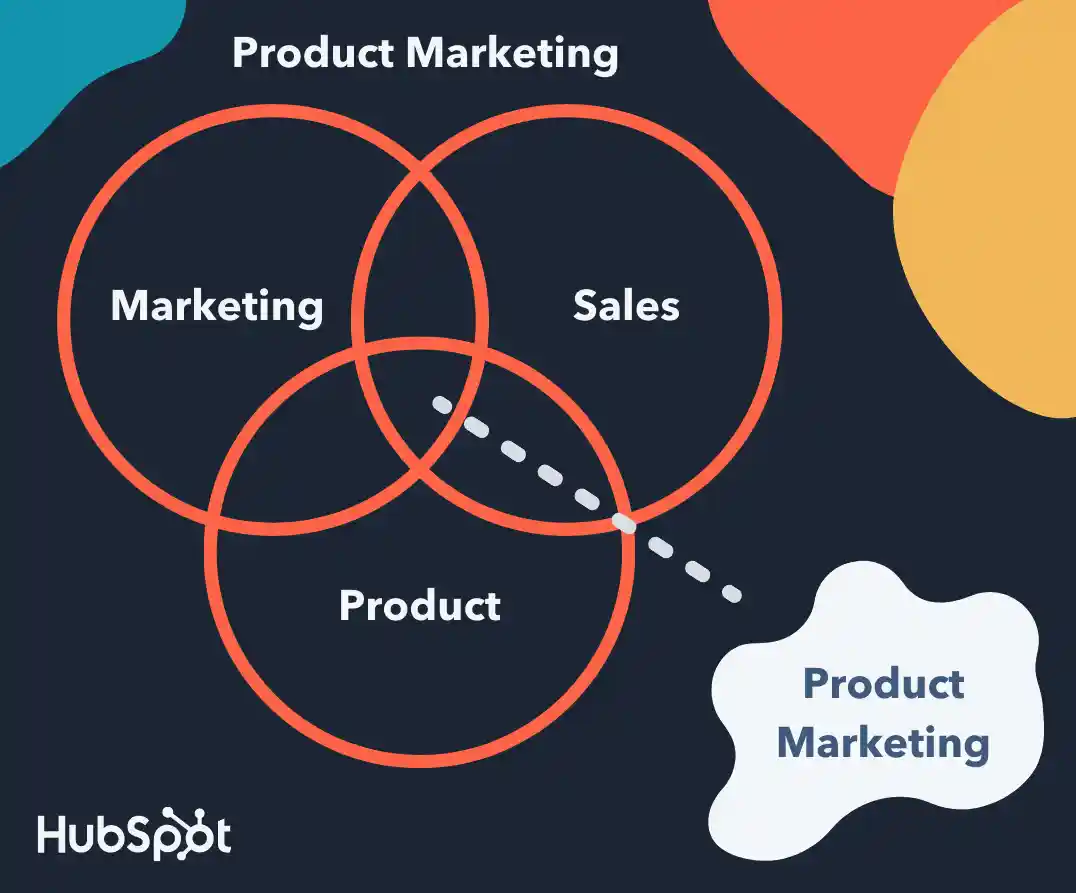
Marketing cares about buyers too, but it casts a much wider net.
Pierri details “The broader discipline of marketing has many interests ... marketing the brand, marketing the culture, marketing the vision, and a host of other concerns. But at the end of the day, people are shopping for products. And product marketing helps explain how the product itself will solve their pain points."
Of course, both marketing and product marketing help a company generate revenue, but while the former pulls many levers to make that happen, product marketing only has eyes for the product's success. (How romantic.)
Product Marketing Goals
Moving right along, product marketing is usually implemented with six goals in mind:
1. To know your audience better than anyone.
A great product marketing strategy helps your target audience see the value of having your product in their lives. That said, one of the primary goals of product marketing is understanding your customer’s needs, wants, and interests and determining how your business can help.
People need to know you “get them,” and that’s product marketing’s job.
2. To effectively target your buyer persona(s).
Once product marketing understands your audience, they need to define your specific buyer persona (s) and refine your marketing tactics accordingly.
This detailed understanding of your target audience and how they interact with your product is what can make product marketing critical to scaling your product and ensuring its longevity, but more on that later.
3. To understand and outdo your competitors.
Bringing a new product to market is like trying to be a thought leader on LinkedIn — crowded. You will have competition, and if you want to rise above it, you have to know what you’re up against.
What are your competitor’s key features and benefits? What ideas haven’t they explored? What does their product offer that yours doesn’t?
Let’s say I take off my writer hat for a minute and magically become a product marketer for HubSpot. Salesforce would be an obvious competitor for me to research.
I might identify that HubSpot allows me to nurture leads without manual maintenance, whereas Salesforce is not designed to nurture leads.
This insight should be incorporated into your product marketing strategy to give you an extra edge.
4. To differentiate your product in the market.
Sneakers are a dime a dozen today, so how has Nike managed to rise to the top? Differentiation.
To stand out in your market, you must be loud about your differentiators. You need to offer something unique that forces consumers to pay attention. This might be quality, a fun personality, or something to aspire to (like Nike’s elite athletes).
Product marketers are in charge of finding and drilling into those differentiators.
5. To get marketing, product, and sales teams on the same page.
If you go into a car dealership and one salesperson tells you car A is rated the highest in safety, but then another tells you car B is, you’ll be confused.
You probably won’t want to buy your new car from salesperson A or B because you don’t know who or what to believe. Consistency is important.
That’s why, once positioning is nailed down, product marketing must drive the adoption of that positioning to your company’s internal teams.
Marketing, product, and sales teams regularly communicate about your product; they must be aligned on what to say.
This means defining, documenting, and communicating talking points around your product’s:
-
Key features and benefits
-
Value proposition
-
Price point
-
Positioning
6. To boost revenue and improve sales.
This may seem obvious, but product marketing is ultimately working to boost revenue and improve sales. All other goals roll up to this.
So, how do these goals translate into specific tasks and responsibilities?
Product Marketing Responsibilities
- Researching and monitoring your target audience.
- Ensuring your product meets the needs of your target audience.
- Determining your product’s positioning in the market.
- Creating, managing, and carrying out your product marketing strategy.
- Enabling sales to attract the right customers for your new product.
- Influencing marketing strategy and product development.
- Keeping your product relevant over time.
Like many things in business, product marketing responsibilities may vary based on your industry, company, products, company size, and resources.
If you’re working as a product marketer at a startup, for example, you may also find yourself creating content for the broader marketing team due to limited resources and budget. I encountered this a lot with agency clients who came to us with big dreams and small budgets.
As they grew, product marketing began to play a separate, equally important role.
When companies reach this point, the goals I mentioned earlier lend themselves to seven common product marketing responsibilities. Let’s run through them:

Free Product Go-to-Market Kit
Free templates to ensure that your whole team is aligned for your next product launch.
- Product Launch Template
- Product Roadmap Template
- Sales Plan Template
- And more!
Download Free
All fields are required.

1. Researching and monitoring your target audience.
As a product marketer, your primary focus is on your target audience and narrowing it down to specific buyer personas.
This means researching them thoroughly and staying apprised of any changes in their behaviors, wants, or needs. These insights are key to addressing your audience's challenges in your messaging and helping your product team iterate to stay relevant.
Pro tip: Use templates to create buyer personas for your business. A formal document about whom you’re catering to can help align different teams in your business.
2. Ensuring your product meets the needs of your target audience.
If your audience does not want or need your product, no amount of marketing will sell it. As a product marketer, it’s your responsibility to make sure there’s a fit.
Your buyer persona and target audience research will uncover the pain points and challenges your product should solve. If your product doesn’t meet these, buyers will have no reason to make the purchase or choose your product over others.
In product marketing, you must understand “why” your buyer needs your product. If that’s unclear, a larger product-market fit issue may be at play.
3. Determining your product’s positioning in the market.
Are you the most affordable option? The most reliable? The most user-friendly? Think of product positioning as telling your product’s story. As a product marketer, you should craft a story around the value of your product that will resonate with your buyers; a story they’ll want to be a part of.
So, what does this look like?
Good product positioning typically tells an audience three things:
1. What your product brings to the market
2. How it compares to others (aka your competitors)
3. How it should be viewed by customers
One of the most well-known examples of product positioning can be seen in Apple’s iconic “Get a Mac” campaign from the early 2000s.
In this campaign, Apple directly compared its Mac computers to PCs by giving them both real-life human personas.
How did this campaign check all of the boxes above? Well, in each spot, the brand:
1. Highlighted different features and benefits of a Mac
2. Directly compared Mac to PC (its biggest competitor) in those areas
Personified how Apple wanted Macs to be perceived by buyers with human characters — i.e., Mac was young, playful, and casual in a hoodie, while PC was older, serious, and literally “buttoned up” in a suit and tie.
We’ll dive deeper into how you can successfully position your product when we talk strategy in a bit.
4. Creating, managing, and carrying out your product marketing strategy.
Speaking of strategy, a product marketing strategy is what allows you to create, build, and deploy content and campaigns to drive sales. It guides the steps that will lead your buyer personas to engage with your product and eventually make a purchase — and product marketers own it.
5. Enabling sales to attract and close customers for your new product.
Product marketing also maintains a direct relationship with sales.
As a product marketer, you’ll work with sales to identify and attract the right customers and provide sales enablement materials to help close them.
This way, all teams are on the same page with what should be communicated to customers, allowing you to provide a consistent, on-brand experience for anyone who comes in contact with your product.
6. Influencing marketing strategy and product development.
As a product marketer, you’re in the unique position of being able to influence both marketing and product development. In other words, you have an impact on how a product gets marketed to its target audience, but also if existing products get updated or new ones are developed.
You must keep your finger on the pulse of what’s changing with your audience and competitors and how your current products are performing to offer actionable advice on next steps.
7. Keeping your product relevant over time.
A customer is only as good as their lifetime value, and keeping your product relevant is the best way to increase that value and avoid churn.
As needs, expectations, and challenges evolve, it’s your job to keep your product marketing strategy (and the products themselves) relevant to customers.
This is one place where product marketing can shine.
Why is product marketing important?
Product marketing focuses on changes in your audience’s needs and behaviors, and it enables your company to adapt quickly in ways general marketing does not. It can be the difference between staying relevant and becoming obsolete, so it’s critical companies don’t forget it.
Take this real-world example of successful product marketing from German automobile manufacturer Volkswagen.
During the 1950s, Volkswagen introduced a vehicle you may know as the “VW bus.” The microbus was a hit and remained an icon for the car company with its signature look for decades.
Fast forward to 2017 and Volkswagen announced the ID.Buzz — a new VW bus that’s electric, full of modern features, and puts a fresh spin on the classic microbus design. The company’s product marketing was colorful and youthful, complementing the original “hippie” vibe the brand was once known for.

It also released a TV commercial driving home these sentiments for buyers.
In this spot, Volkswagen cleverly introduces the new vehicle with the beloved 1960s’ Simon & Garfunkel song “The Sound of Silence” playing in the background (hint: electric cars are silent) and ends with a short on-screen message that reads: “Introducing a new era of electric driving.”
The commercial is fun, touches on the vintage origins of the bus, and makes it clear that Volkswagen is entering a new era with an electric, eco-friendly vehicle.
So, the million-dollar question: Did the campaign work?
While not even available in the United States yet, Volkswagen Commercial Vehicles reported nearly a 25% increase in sales in 2023, with deliveries of the ID.Buzz quadrupling, according to InsideEVs. I think it’s safe to say that’s a yes.
The campaign didn’t focus on the Volkswagen brand but on the VW bus and the position it holds in the buyer’s mind.
By paying attention to its audience and market, the company evolved a previously successful product and made it new again with clever positioning and a product marketing campaign to match.
This is a prime example of a great product marketing strategy at work. How can you build yours?
Product Marketing Strategy
Your product marketing strategy guides the positioning, pricing, and promotion of your new product. It helps you take your product from development to launch and informs what new audience(s) and markets to target.
Product strategy is nuanced. It requires more than just the paragraphs below, but here are five key steps to get you started.

Free Product Go-to-Market Kit
Free templates to ensure that your whole team is aligned for your next product launch.
- Product Launch Template
- Product Roadmap Template
- Sales Plan Template
- And more!
Download Free
All fields are required.

1. Perfect your product’s buyer personas.
Defining a target audience and perfecting your buyer personas is crucial for a successful product marketing strategy.
Understand your customers, their needs, challenges, and pain points, and you’ll be able to ensure all aspects of your product marketing strategy, campaigns, and assets resonate with your buyer.
2. Clearly define your differentiators and positioning.
What sets your product apart? Why should buyers choose you over your competitors? A successful product marketing strategy needs clearly defined differentiators and a positioning statement.
When done right, this positioning statement answers key questions your customers might have about your product and shares what makes it unique (i.e., why they should buy).
Start by answering questions like:
-
Why was this product made?
-
Who is this product made for?
-
What challenges does this product resolve?
-
What makes our product unique?
-
Why is our product better than and different from those of our competitors?
-
Why are our product’s features ideal for our target audience?
-
Why should our customers trust and invest in us and our product?
From there, you‘ll want to compile these responses into a brief, impactful positioning statement. Keep these tips in mind:
-
Use action words to excite your customers.
-
Ensure the tone of your statement captures the style of your brand.
-
Focus on the benefit of your product as a whole (not just one specific feature).
Pro tip: As product marketers, ensure the sales, product, and broader marketing teams are also aware of your product positioning so everyone conveys the same information to prospects and customers. You can also share this information with your support team since they’re speaking with customers who’ve already invested in the product.
3. Set your goals.
What do you want to accomplish? Setting goals for your product will guide your strategy and be a reminder of what your marketing efforts are working towards. Goals will vary depending on your product, the type of company you work for, and your larger marketing goals, but some of the most common include:
-
Increasing revenue
-
Engaging with customers
-
Improving market share
-
Gaining customers from competitors
-
Boosting brand recognition
Pro tip: Set your targets using the SMART goal format, which means they should be specific, measurable, attainable, realistic, and time-bound.
Use a free template to help you create and achieve your SMART goals.
4. Price your product.
Product marketing heavily influences your product’s pricing. Typically, this manifests as a choice of competitive versus value-based pricing.
Competitive vs. Value-Based Product Pricing
Competitive pricing means the price of your product is based on similar products your competitors sell and how they compare. Suppose you believe your unique features warrant a significantly higher price than those of your competitors. In that case, with competitive pricing, you might price your product above the average.
On the other hand, value-based pricing quantifies your item’s price based on what a customer gets tangibly or intangibly (think a boost in confidence or elite status). This allows you to be more fluid with your pricing rather than just following the market, industry trends, and what your competitors say.
It also allows you to maximize your profit, although it can be more difficult to educate customers on why your price is so variable. Value-based pricing is ideal for companies selling a product with very few competitors — or one with exceptionally new and unique features.
5. Launch your product.
The product launch is the most important — and exciting — part of any product marketing strategy.
Product marketing focuses on two aspects of a launch: the internal launch (what goes on inside your company during a product launch) and the external launch (what goes on outside your company, with customers and audience members, during a product launch).
Internal Aspects of a Product Launch
During the internal product launch, you should get your marketing, product, and sales teams clear on:
-
The product’s benefits
-
Any available product demo information
-
Sales product training opportunities and details about how it’s used
-
What the positioning and messaging look like
-
Who your buyer personas and ideal customers are
-
What the goals for your product include
-
What your product’s features are
-
The pricing of your product
-
How your product is being launched to customers
This information can be communicated in a number of ways, including:
-
Sales enablement kit (ideal for your sales team)
-
Presentation (ideal for marketing including product)
-
Knowledge base (ideal for your support team)

Free Product Go-to-Market Kit
Free templates to ensure that your whole team is aligned for your next product launch.
- Product Launch Template
- Product Roadmap Template
- Sales Plan Template
- And more!
Download Free
All fields are required.

External Aspects of a Product Launch
The external launch of a product is a totally different beast.
As you know, there are really no rules about marketing your product, so get creative. A product launch may include social media, public/in-store displays, product launch events, blog articles and content, website landing pages, or even a flash mob.
What your product launch entails comes down to your brand, product, and audience. But let’s go into some practical tips on how to market a product that almost any business can adopt.
How to Market a Product
- Highlight benefits, not features
- Position your product as a solution in your blog content
- Show your product in action using video
- Create a referral or affiliate program
- Try co-marketing with another brand
- Bid on your competitor’s keywords with PPC ads
- Let people try before they buy
- Collaborate with creators/influencers
- Encourage user-generated content creation on social media
- Showcase social proof
- Create a product deck or media/press kit
- Perfect the cross-sell and upsell
1. Highlight benefits, not features.
Regardless of the channel or platform, highlight the benefits of your product rather than its features. Unless you offer features your competitors don’t, they’re likely not a differentiator for you.
Furthermore, features (like “customizable attribution models” or “automated email workflows”) can often be technical and hard for buyers to understand. Benefits translate your features into relatable, human value.
When leading with benefits, the examples above become “Know where exactly your leads come from” or “Save time by automating tasks using contact workflows.”
The HubSpot Marketing Hub landing page does a great job here.
It reads: “AI-powered marketing software that helps you generate leads and automate marketing.”

In this copy, HubSpot explains its features and what users can accomplish with them. With this approach, even if you are totally new to inbound marketing, you’d be able to understand what the product will do for you.
2. Position your product as a solution in your blog content.
A company blog is a powerful place to drive organic traffic and build awareness and demand for a product. Rather than hammering visitors with facts, figures, and sales pitches, write content about a related problem that your product solves.
Take this example from the messaging app Slack.
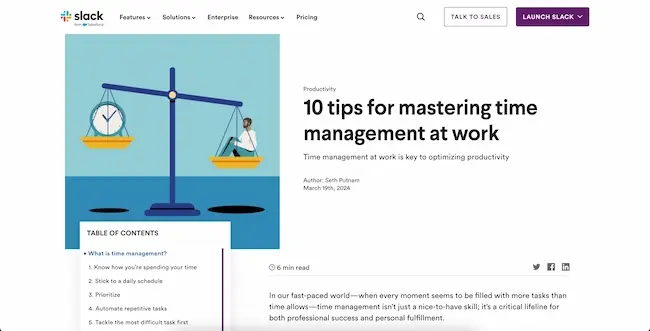
In this post, Slack addresses the common audience pain point of wanting to manage their time better and be more productive. It details 10 different tips readers can try while occasionally mentioning the Slack product and its relevant features where appropriate.
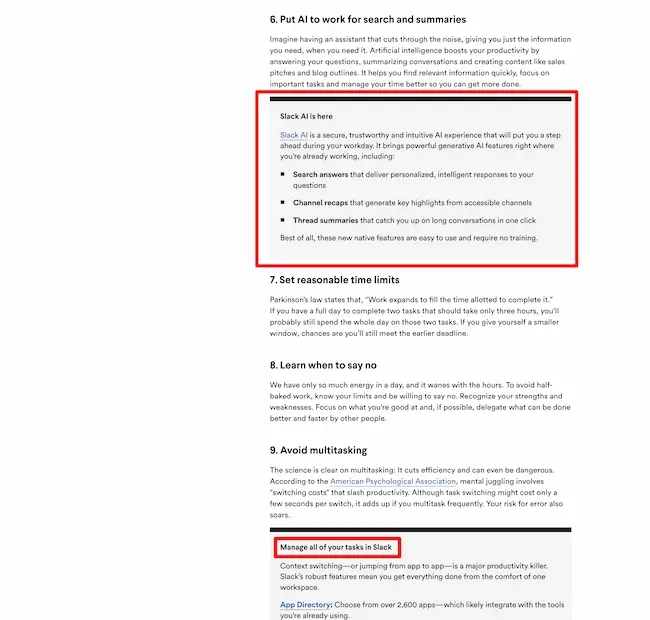
This is a smart and subtle way of introducing the Slack product as a potential solution to the reader’s problems while also delivering real, actionable, educational value.
3. Show your product in action using video
A written blog is great, but a video showing your product in action? That can be even better.
Next to trying your product (which we’ll talk about shortly), watching a video of your product in use is the closest a buyer can get to experiencing it. For this reason, video content can more quickly and effectively convert your audience. So, use this to your advantage.
But the best thing about video content? You don’t even need an excessive budget for creating it. Just get yourself free video editing software and start making your marketing masterpieces.
Create video content for your product that can include:
-
Tutorials on how to use your product
-
Hacks your product can be used for
-
Product demonstrations
-
Product reviews
-
Unboxing videos
Mattress manufacturer Purple has some great product marketing videos on its YouTube channel.
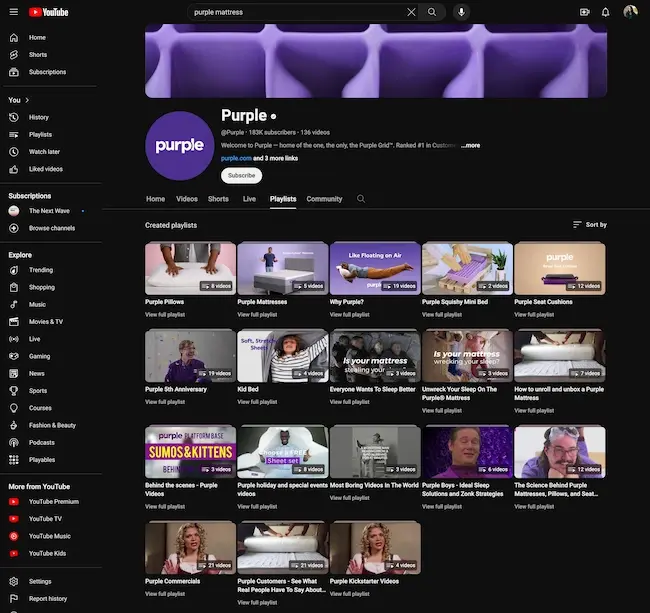
The channel includes a mix of product demonstrations, how-tos, testimonials, and even manufacturing highlights, letting their target audience get a closer look at what Purple offers.
4. Create a referral or affiliate program
According to Nielsen, 88% of consumers trust recommendations from people they know more than any other channel. Word-of-mouth marketing still reigns supreme over any marketing message or sales pitch you release.
With that in mind, one of the most effective ways to promote your product is creating a customer referral program (or affiliate program). In a referral program, past or happy customers are asked to recommend your product to new people. If they drive a purchase, the referrer is rewarded through commission, discount, or another type of gift.
In this situation, people typically feel more inclined to make a purchase because someone they trust has given your product their vote of confidence. As a business, you get a new customer with very little effort, and the referrer is compensated for their input. It’s a win for all.
Let’s take a look at meal kit company EveryPlate’s referral program. In this example, customers are playfully encouraged to “feed their friends.”
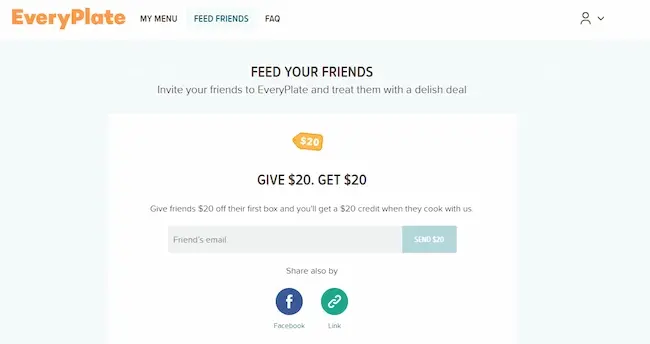
The page reads, “Give your friends free meals of their choice! In return, you will earn $30 when they place their first order.”
Referral programs like this one are quite popular today and come in many forms. Learn how to build the right one for your product in our article, “How to Create a Strong Referral Program.”
5. Try co-marketing with another brand.
Co-marketing or co-branding with another brand is an excellent way to market your product to an engaged and qualified audience.
You can do something as simple as going live on Instagram or YouTube together or as big as teaming up on an original research campaign or co-hosting a live webinar.
No matter what the size, your product should be a natural match for the other company’s customers. Ideally, this means your products can be used in conjunction.
Here’s a great example of co-marketing from the social media app Pinterest and the clothing brand Levi’s.
In this campaign, Levi Strauss & Co. joins forces with Pinterest for “Styled by Levi’s” — what they describe as a “personalized styling experience” or tailored style insights from Levi’s through pins on a Pinterest board.
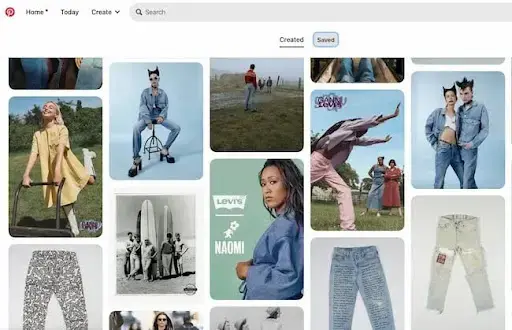
As Sophia Barron, Director of Product & Channel Marketing at Owl Labs, explains, “People often turn to Pinterest for fashion inspiration, making a co-branding partnership with Levi‘s a natural partnership … Pinterest offers Levi’s a leading social platform with millions of users interested in visual offerings, and Levi's meets these needs with digital personalization and visual-focused boards.”

Free Product Go-to-Market Kit
Free templates to ensure that your whole team is aligned for your next product launch.
- Product Launch Template
- Product Roadmap Template
- Sales Plan Template
- And more!
Download Free
All fields are required.

6. Bid on your competitors’ keywords with PPC ads.
Pay-per-click (PPC) is an essential product marketing tactic. While content and social media marketing can help you attract inbound leads, you can get the attention of even more potential customers by buying PPC ads on search engines.
Let’s say you work for HubSpot. (Hey, welcome on board!)
When setting up your PPC campaign, bid on general product keywords (such as “CRM software”), your own branded terms (like Marketing Hub, HubSpot), and your competition’s (e.g., Salesforce).
This way, customers who search for your competitor’s name as they consider a purchase will see your name and product at the same time.
7. Let people try before they buy.
Finding new, effective ways to convey the value of your products isn’t easy. Words, videos, and other passive marketing content can only do so much.
When you allow your audience to try your product before they buy it, they can experience the value firsthand without any risk.
It’s like test-driving a car before signing the lease or trying a sip of wine before buying the bottle.
Allowing your audience to try your product lets them know, without a doubt, how it functions and how they’ll interact with it. This experience can answer many questions and eliminate a lot of the doubt one might have to making a purchase.
Depending on the nature of your product, “trying” your product can look different, but some popular options include:
-
Free sample
-
Free demo
-
Free or limited trial
-
Freemium tier/level
At HubSpot, we implement this product marketing tactic with our freemium model. Users can get started with the foundational tools of any of our products without even putting down a credit card.
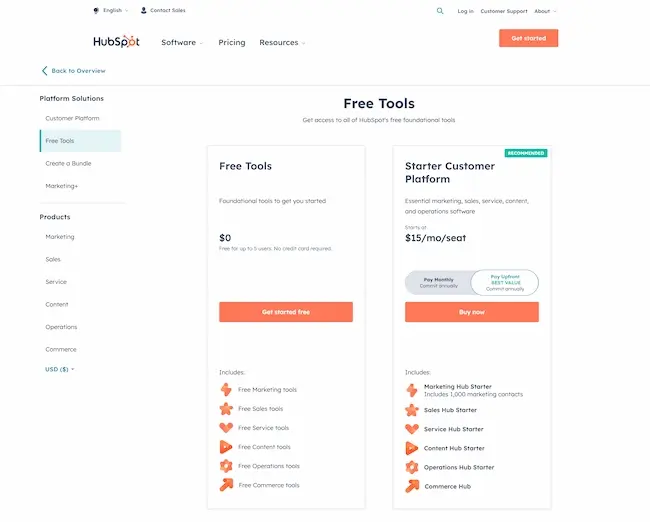
8. Collaborate with creators and/or influencers.
As we’ve seen with co-marketing and referral programs, collaboration can be a game changer in your product marketing strategy. It helps expand your reach to new, relevant audiences and capitalizes on your partner's trust with that audience.
That said, social media creators and influencers are some of the most powerful folks to partner with today.
Similar to a referral program, creator or influencer marketing typically offers your partner some sort of compensation (usually payment or a free product) in exchange for promotion on their social media platform.
This could be doing a product review that features the product in a post or hosting a giveaway for the product.
This is a popular tactic in the beauty industry. Take this collaboration from South Asian makeup influencer Aditya Madirjaru and luxury beauty brand Lancome.
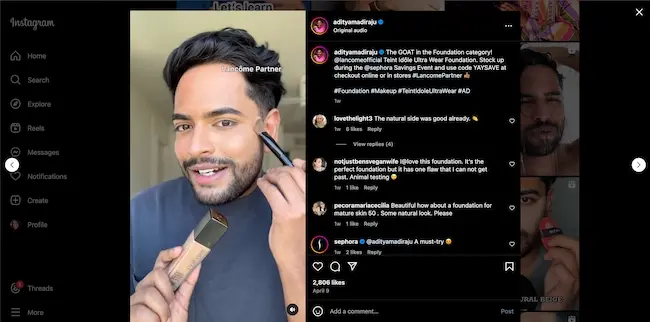
In this Instagram reel, Madirjaru, a Lancome partner, encourages his 1.4 million followers (including yours truly) to purchase Lancome’s Teint Idôle Ultra Wear Foundation.
He first shows the product on camera and then applies it to demonstrate coverage. Paired with commentary raving about the product, this video is a top-tier example of influencer marketing done right.
9. Encourage user-generated content (UGC) creation on social media.
Considering the video above, having your buyers create content on social media is another smart way to market your product.
The majority of consumers trust other real-life buyers more than they trust brands themselves. So, use this trust to your advantage with a user-generated content campaign.
Encourage your buyers to share their experience with your product by tagging your brand or using a specific hashtag on social media. Doing this will get your product in front of new audiences expanding your reach, building awareness, and acting as social proof of the value your product delivers.
GoPro’s use of user-generated content is admirable.
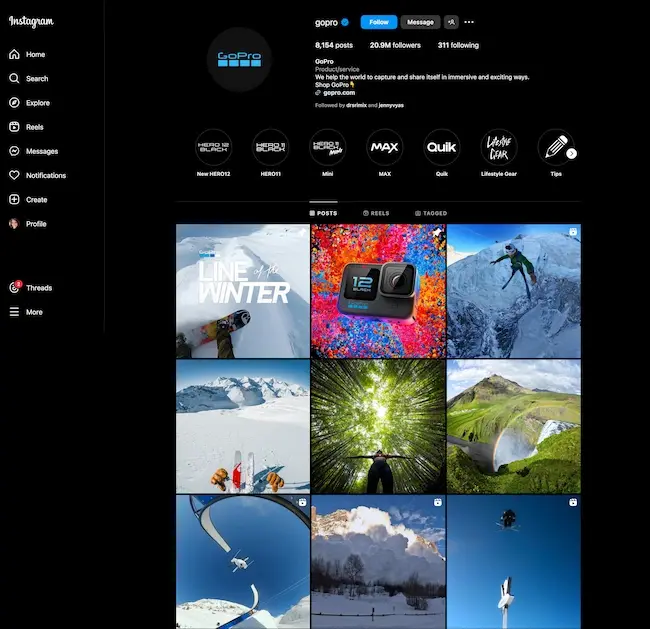
On its Instagram profile, the camera and technology company almost exclusively shares content filmed or shot by its subscribers with its products.
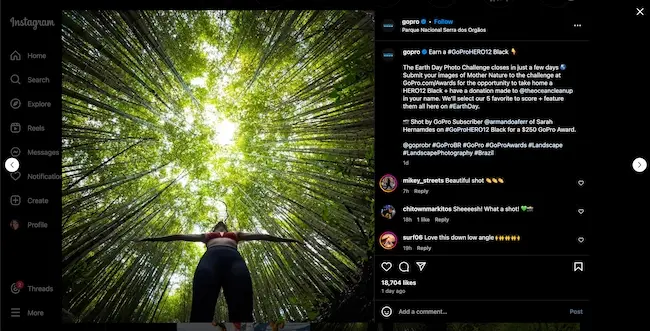
This gives buyers a moment to shine in front of the brand's over 20 million followers and showcases some of the amazing results their product can produce.
10. Showcase on social proof.
UGC is just one example of how to market your product using social proof.
Social proof in marketing is something that encourages a buyer to take action (read: buy your product) because it shows others have done it successfully or without harm.
Forms of social proof in marketing include user-generated content, as well as:
-
Product reviews
-
Product ratings
-
User Testimonials
-
Usage numbers and statistics
-
Industry Awards
-
Social Media Shares
-
Celebrity Endorsements
Using social proof in your product marketing can be as simple as including a celebrity quote about your product on your website. It might also look like including product ratings on a form like community software company Circle does in this pop-up on their website:
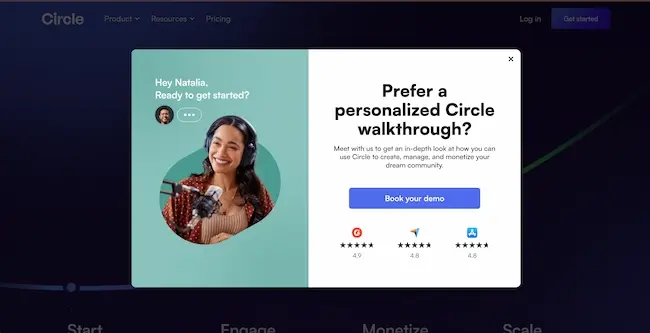
The pop-up urges website visitors to book a demo of the company’s product and includes its impressive ratings from respected sources G2, GooglePlay, and the Apple App Store.
11. Create a product deck or media/press kit.
People outside of your organization won’t always know the best way to talk about your product, even if they want to.
To enable organic promotion of your product, consider putting together a marketing deck, presentation, or press kit that details everything a potential buyer should know about your product and provides assets like logos, photos, and color swatches.
If someone is inclined to feature your product in an article, make a video about it, or even collaborate. They’ll know your exact positioning and audience, among other things.
Learn how to put together your media kit and see examples in our article, “What is a Media Kit — and How to Make One.”
12. Perfect the cross-sell and upsell.
In the HubSpot 2024 State of Sales Report, we found that 91% of sales professionals upsell, and team upselling tactics drive, on average, 21% of company revenue.
That’s nothing to scoff at. Take some time to consider how you can cross-sell or upsell your audience on your products. In other words, how can you encourage sales by pairing or comparing your product with other items in your catalog?
For example, Apple promoting a pair of AirPods when you purchase a new iPhone without a headphone jack, is a cross-sell. Apple promoting the iPhone 15 Max Pro when you are considering buying the iPhone 15 Max is an upsell.
If you have existing successful products, explore how they can work with your new products and incorporate those connections into your product marketing.
Product Marketing Examples
- Apple
- Billie
- Coca-Cola
- Uber
As we close, let's quickly review four more real-life examples of stellar product marketing from reputable brands to drive home what we’ve learned.
1. Apple
Apple is a household name for leading technology products and software. Not only are its products gorgeously well-designed, but they are super useful.
Recognizing this, Apple‘s product marketing doesn’t focus on its many product features but on the user benefits.
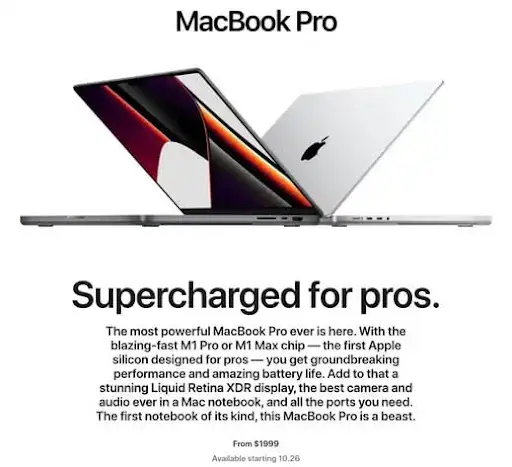
In this feature for the Macbook Pro laptop, Apple doesn't simply list the impressive features of the laptop, it uses those features to tell consumers who they could be and how much better they could perform if they had it.
Apple weaves a narrative in its product marketing that describes the value it offers and gives buyers something to aspire to. It’s this smart marketing that allows Apple to lean into its value-based pricing.
2. Billie
Billie is a women's razor brand. In a highly saturated market, Billie arguably doesn’t have anything unique to offer, but the company manages to differentiate itself by doing what few women’s razor brands have done before; actually showing body hair.
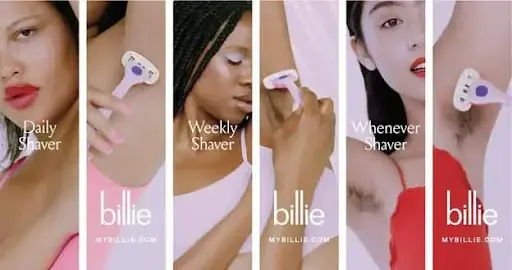
Body hair and shaving can be an uncomfortable discussion topic, so many razor brands lean into portraying a specific lifestyle. But Billie tries something different. It sheds taboos and positions itself as a real hair removal solution, no matter your frequency or background. With this messaging, Billie stands out from its competitors while also helping to remove the stigma around something natural and universal.
3. Pepsi Cola
Pepsi has always positioned itself as a product with youthful energy and excitement. This can be seen consistently through its celebrity endorsement product marketing campaigns.
Pepsi's customers are mainly aged 13-35 years old with modern and active lifestyles, so it only makes sense that the company would partner with celebrities popular with this demographic ( e.g., Britney Spears in the 2000s and Doja Cat in the 2020s).
This is one tactic that the beverage company has regularly employed over the decades that’s arguably helped it remain a household name and product.
4. Uber
Ride-sharing app Uber was a pioneer in its space. Paying close attention to its target market, the company recognized a flaw in traditional taxi services and presented a new, arguably better, alternative.
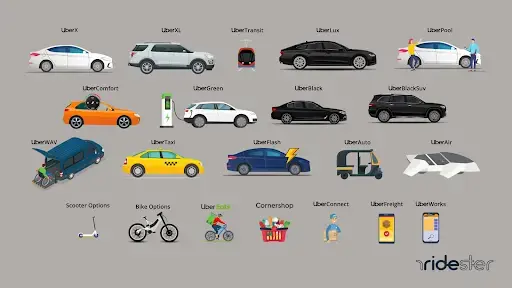
While other competitors like Lyft and Revel have emerged, Uber has stayed relevant and expanded into services like Uber Freight, Uber for Business, and UberEats.
This is a brilliant example of not just product marketing but also product innovation.
Start Marketing Your Products with Confidence
Being a product marketer (or product marketing manager) means you’re a major player in your company’s marketing, sales, and product future.
You create and manage your product’s specific marketing strategy, but you also serve as a liaison between all three departments, ensuring everyone is on the same page with your product, its features, capabilities, and more.
Product marketing is an integral part of a greater marketing strategy and business success. So, take the advice and examples we’ve outlined above and start building a strong foundation for your product marketing today and for years to come.
This post was originally published in February 2020 and has been updated for comprehensiveness.
Product Marketing





![The 6 Stages of the Product Life Cycle [+Examples]](https://53.fs1.hubspotusercontent-na1.net/hubfs/53/product-life-cycle_0.webp)

![How to Create a Product Launch Email [Outlines + Templates]](https://53.fs1.hubspotusercontent-na1.net/hubfs/53/create-a-product-launch-email_5.webp)



